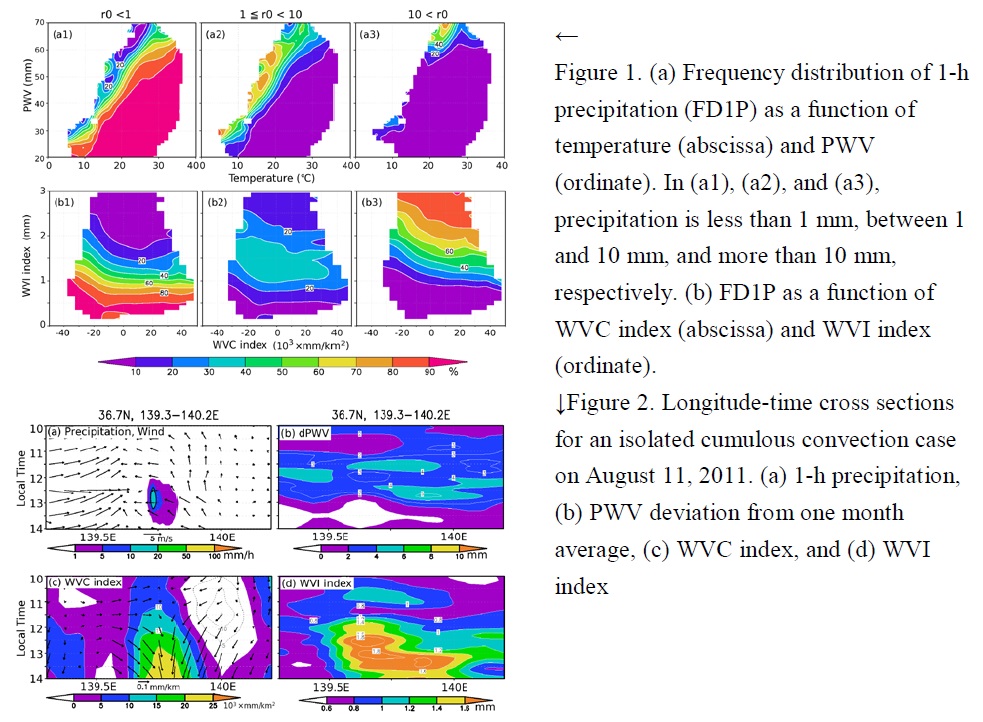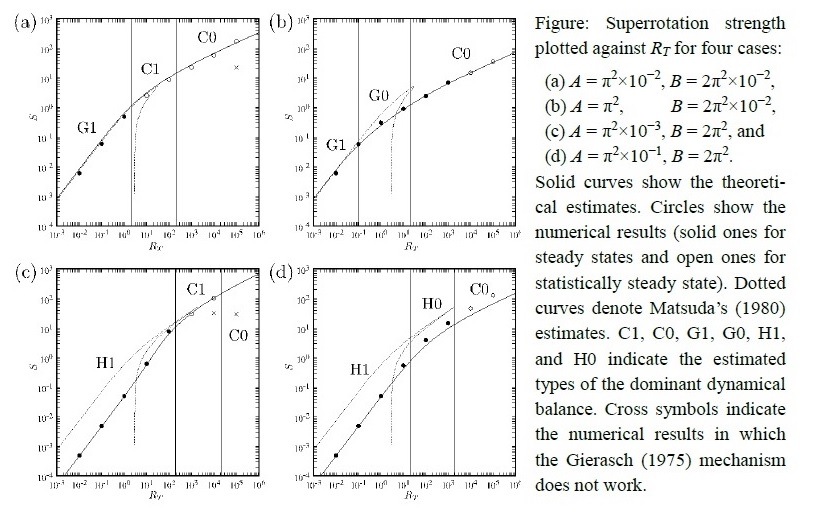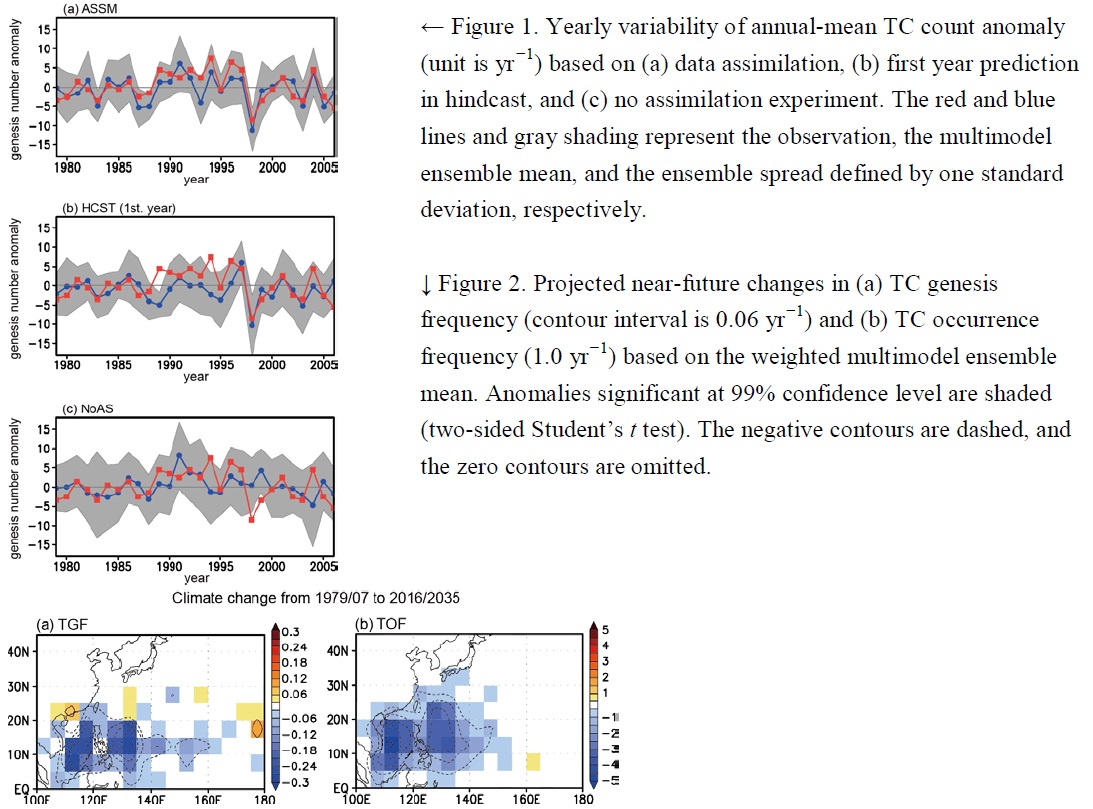JMSJ Awards
JMSJ Awards in 2013
The JMSJ editorial committee presents the JMSJ Award to outstanding papers published in a year. In 2013, the following three papers are awarded: JMSJ Award 2013
Shoji (2013)
Shoji, Y. 2013: Retrieval of water vapor inhomogeneity using the Japanese nationwide GPS array and its potential for prediction of convective precipitation. J. Meteor. Soc. Japan, 91, 43-62.
https://doi.org/10.2151/jmsj.2013-103
Graphical Abstract
Highlights:
- Procedures for retrieving two indices indicating the degree of inhomogeneity of water vapor using the carrier phase of a global positioning system (GPS) have been introduced. One index (WVC) describes the spatial concentration of water vapor, while the other (WVI) indicates higher-order water vapor inhomogeneity. Horizontal scales of the two indices are approximately considered to be 60 km and 2-3 km, respectively.
- The relations between these indices and precipitation were examined statistically. The results indicate that the inhomogeneity indices are more strongly correlated with strong rainfall than PWV. PWV seemed to relate to precipitation of less than 10 mm h?1, but did not exhibit much of a relation with precipitation greater than 10 mm/h (Figure 1). These relations hold true for both present and imminent precipitation.
- The spatiotemporal variations in the indices of a thunderstorm on August 11, 2011, were also examined. Both WVC and WVI indices indicated an increase ahead of the initiation of convective precipitation (Figure 2).
Yamamoto and Yoden (2013)
Yamamoto, H. and S. Yoden, 2013: Theoretical estimation of the superrotation strength in an idealized quasi-axisymmetric model of planetary atmospheres. J. Meteor. Soc. Japan, 91, 119-141.
https://doi.org/10.2151/jmsj.2013-203
Graphical Abstract
Highlights:
- This paper presents a theoretical estimation of the strength of equatorial superrotation in planetary atmospheres by exploring quasi-axisymmetric primitive equations with the effects of non-axisymmetric eddies parameterized by strong horizontal eddy diffusion. In this system, the superrotation is maintained by the Gierasch (1975) mechanism.
- A quintic equation for the superrotation strength is developed from the primitive equations; estimates are given by its unique positive solution. The solution depends only on three non-dimensional parameters: the external thermal Rossby number (RT), the ratio of the radiative relaxation time to the timescale for the vertical diffusion (A=π2 τ Ω EV), and the square of the ratio of the planetary rotation period to the geometric mean of the timescales for the horizontal and vertical diffusion (B=20 π2 EHEV).
- The parameter dependence of the dominant dynamical balance is also investigated. The balance is a cyclostrophic (C·), geostrophic (G·), or horizontal diffusion balance (H·), and in each balance, the equator-to-pole temperature difference is either nearly equal to that in radiative-convective equilibrium state (·1) or significantly reduced by thermal advection (·0).
- Numerical solutions of the primitive equations are obtained for a wide parameter range and the obtained superrotation strength (solid and open circles in the figure) agrees well with the theoretical estimation (solid curves), showing the validity of the present theory.
Mori et al. (2013)
Mori, M., M. Kimoto, M. Ishii, S.Yokoi, T. Mochizuki, Y. Chikamoto, M. Watanabe, T. Nozawa, H. Tatebe, T. T. Sakamoto, Y. Komuro, Y. Imada, and H. Koyama, 2013: Hindcast prediction and near-future projection of tropical cyclone activity over the western North Pacific using CMIP5 near-term experiments with MIROC. J. Meteor. Soc. Japan, 91, 431-452.
https://doi.org/10.2151/jmsj.2013-402
Graphical Abstract
Highlights:
- Interannual and multiyear predictability of tropical cyclone (TC) activity in the western North Pacific (WNP) is explored, using three versions of the coupled atmosphere-ocean model, MIROC. In addition, global warming impacts on TC activity in the near-future are also examined.
- Initialized decadal hindcasts show that year-to-year variation of TC number reasonably captures the observation (Fig. 1). On the multiyear timescale, skillful prediction of TC number is likely difficult at least in our hindcasts, but three-year-mean states of hindcast started in 1998 reasonably capture observed major characteristics of TC activity associated with the Pacific climate shift during the late 1990s through the initialization.
- Projected near-future (2016-2035) change in TC number shows significant reduction (approximately 14%) especially over the western WNP (Fig. 2) even in the near-future when global warming is not so prominent compared with the end of this century.









